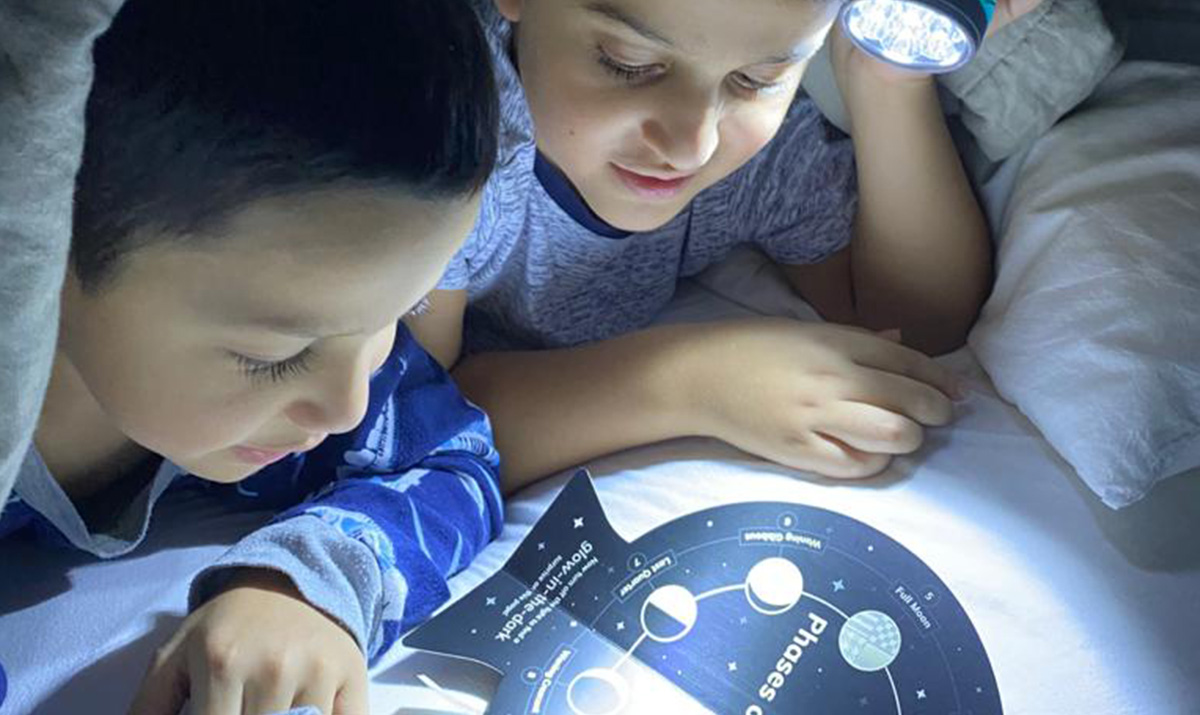
The inspiration for ‘My first book of Islamic Months’ actually came from another book I’d wanted to publish for some time!
I had noticed many of my friends’ young children took an interest in learning about the phases of the moon and their mothers would carefully trim tin foil and wrap it around paper plates, mounting them across the living room wall. Hand lettered cursive signs would be drawn beautifully with the phase names, Waxing Crescent, First Quarter, Waning Gibbous, displayed neatly underneath the metallic rows.
When I looked online, I saw home-schooling mums all over the world were also doing the same. Families wanted to learn more about the moon.
I think most children are fascinated by this majestic lamp in the night sky – as are adults too, let’s not forget!
To this day, my father is still so excited by the beauty of this gloriously suspended signature of God’s creation. Each month’s sharp crescent or full moon brings a appreciative and passionate “SubhanAllah!” and urgent “Beta look, look, come quick” – urging me to drop everything to come and join him in gazing out of the window together.
As a child, my memory of the moon was associated with Prophet Ibrahim (AS). I loved hearing prophetic stories from my father growing up and imagined them so vividly. For instance, there’s a verse in Surah Al-An’am about Ibrahim (AS), who is known for his wisdom from a young age. Ibrahim (AS), in search of his true Lord, went on a journey of faith and discovery, which led him to question the various objects of people’s celestial worship,
and was guided by Allah to become a firm believer from these very reflections.
And when he saw the moon rising, he said, This is my lord. But when it set, he said, Unless my Lord guides me, I will surely be among the people gone astray. (Qur’an 6:77)
Ibrahim (AS)’s logic and rationale was something I found utterly amazing growing up. His confidence and conviction are also a testament to his character and show why he earned his status as the “father of monotheism” in all Abrahamic traditions.
The sun, moon and stars all tie us to this Prophetic legacy in an unspoken way – they’re the very same celestial objects all Prophets gazed at, pondered upon, dreamt about and, in the case of our Beloved Final Prophet (PBUH) even split, all those years ago, SubhanAllah!
With so many relatable connections, I’d often brainstorm and sketch out possibilities of what my moon book could look like, but something always felt as though it was never quite right in that creative process.
With time and some more reflection, it became apparent that while these youngsters were learning the differences between waxing and waning crescents, and how the moon changed over the course of the month, there was an element missing. We needed to inspire children with knowledge of the Islamic months and the significance of them.
And so, it became a matter of priorities for me. I felt, despite the fascination for the moon and her majestic beauty, a logical order had to be in place. Children first needed a fun and creative immersion into Islamic months in order to truly appreciate it in a cycle of Islamic learning.
It was important to establish the roots and foundations for why the various moon phases hold significance for us as Muslims. For example, when we fast the 3 white days, when the moon is at its fullest in the middle of the month – this is the middle of the Islamic, not Gregorian month.
It was important to know the 4 sacred months, which Allah SWT mentions in the Qur’an, and understand that it’s not just war and fighting that is forbidden, but also that our good deeds are magnified during that time.
We can introduce young minds to a new level of consciousness of time and how it passes through familiarising them with the Islamic Months. Layer by layer we can add snippets of knowledge spanning from history to festivities and link them to the event of the Hijrah too. We can teach children the Arabic names and the seasons after which they were named. A seemingly simple topic, yet it holds such rich and expansive information.
And so, the Islamic Months book was published first in 2019, Muharram 1441, in its uniquely interactive Shade 7 way. This meant flaps that held special facts and a concertina fold that allowed the entire book to open, showcasing the Islamic calendar.
And Alhamdulillah a year later in 2020, Muharram 1442 welcomes its little sister, The Phases of The Moon – A tie-back book, with sparkles and a glow-in-the-dark surprise! All those previous moon book sketches weren’t ready – because it just wasn’t their time to be brought into publication. As soon as it was time and Allah SWT decreed it, Alhamdulillah the vision clicked into place and the inspiration flowed.
We are delighted to bring you a book about the Moon, unlike any other, one that forms a miniature moon of your very own, which we hope will become a source of reflection and awe for the Creator of not just the Moon, but the entire universe, insha’Allah.
He is the One Who made the sun a radiant source and the moon a reflected light, with precisely ordained phases, so that you may know the number of years and calculation of time. Allah did not create all this except for a purpose. He makes the signs clear for people of knowledge. (Qur’an 10:5)



